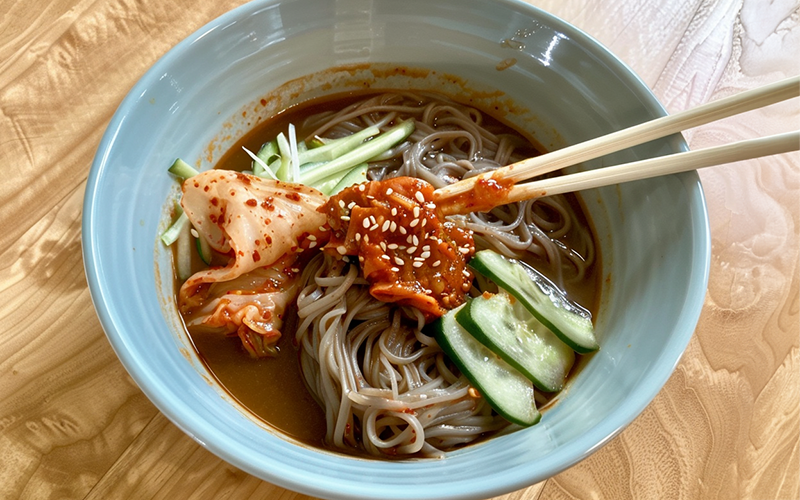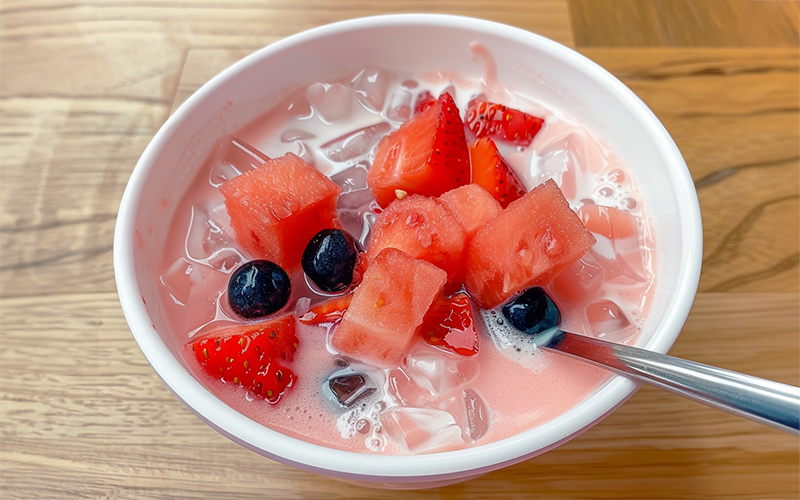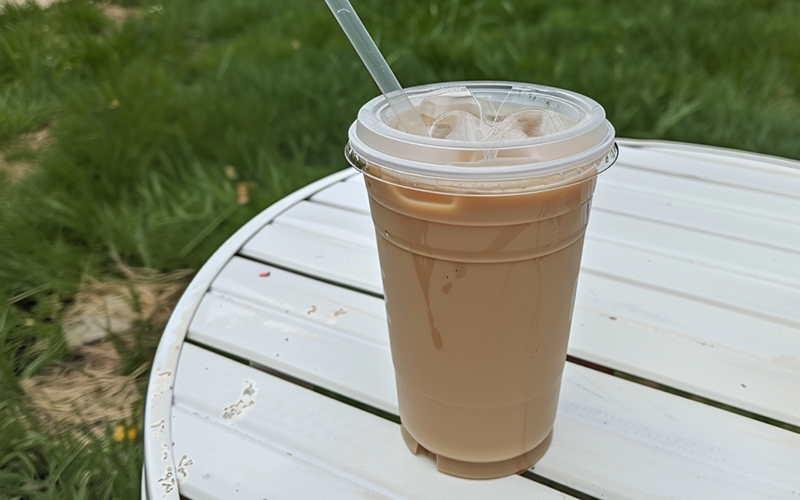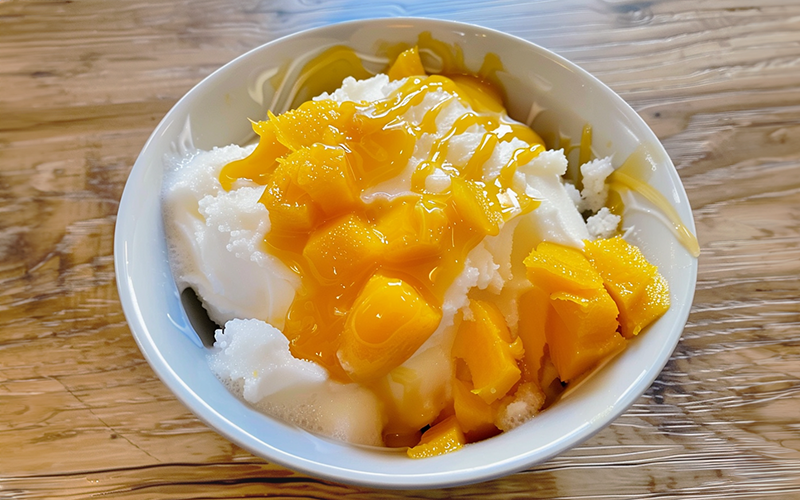By Honorary Reporter Ava Valentine from U.K.
Photos = Ava Valentine
For many visitors to and enthusiasts of Korea, the vibrant summer in the Land of the Morning Calm is synonymous with mouthwatering foods that help beat the heat, ranging from icy sweet treats to bowls of cold noodles.
Nowadays, Korea has expanded its selection of plant-based foods. At Korean restaurants outside of Korea, however, meat and dairy-free menu options can be far and few between. For example, finding vegan Hansik (traditional food) in the U.K. that retains its authentic taste often feels like searching for a needle in a haystack.
Determined to bring a slice of the Korean summer back home, I spent a week doing a challenging but delicious attempt to make vegan versions of popula summer dishes in Korea.
Naengmyeon
These cold buckwheat noodles might just be Korea's most quintessential summer dish and a must for anyone looking to cool down on a hot day.
Traditionally, water naengmyeon is served with a chilled soothing broth and cold buckwheat noodles that are delightfully chewy. The noodles can also be made with sweet potato or arrowroot flour, both great vegan options. The soup, however, is typically made from a combination of beef or chicken and dongchimi (chilled radish kimchi) broth, no doubt delicious but unsuitable for a plant-based lifestyle.
So the biggest challenge was the broth. While dongchimi is suitable for vegans, I found no options without beef at the Korean supermarkets around me. Instead of waiting days for my dongchimi to ferment, I created a rich and flavorful broth using dried shiitake mushrooms and vegetable stock, and later chilled it for about an hour.

My vegan naengmyeon featuring a mushroom and vegetable-based broth and chewy buckwheat noodles is perfect for cooling off on a hot summer day.
Once both the broth and the noodles were ready, I topped the dish with tangy plant-based spicy cabbage kimchi to replace the refreshing sharpness of dongchimi, along with crisp cucumber slices. The resulting bowl of goodness was both cooling and invigorating with its complementary textures and flavors.
Hwachae
This fruit punch has gone viral on social media. Since summer last year, I've seen this yummy drink all over TikTok and Instagram, with many people drinking huge bowls of it at the peak of summer.
Hwachae combines the sweetness of fruit with a light and refreshing liquid base. Historically, it was often made with seasonal fruits and flowers submerged in water sweetened with honey or sometimes sikhye (chilled rice punch).
More recently, the variation I see most contains strawberry milk. The version I made had dairy-free milk.

I made my refreshing hwachae with dairy-free milk, lemonade and fresh fruits to beat the summer heat.
Iced coffee
A popular way to consume drinks in Korea is through ice cups. During my first visit to Seoul in June 2019, these pre-packed cups were everywhere and have since emerged as the bestselling product regardless of season at Korea's popular convenience store chain CU, according to a 2023 report from the Korean daily JoongAng Ilbo.
Better yet, ice cups have appeared on the shelves of Korean supermarkets in the U.K., and I've seen them at the nationwide chain Oseyo. Their beauty is being paired with any drink desired, a great option for vegetarians. My personal favorite is green grape ade.
This time, I had to try a version I see most often on social media: the trendy banana-hazelnut latte combo. This simple combination of a hazelnut coffee pouch and a banana milk drink was incredibly easy to make. I just added a dairy-free alternative to banana milk made with almond and soy milk.

My vegan ice cup coffee had almond and soy banana milk, cold brew coffee and hazelnut syrup.
I picked up a carton and combined it with regular cold brew coffee and hazelnut syrup using my own disposable cup and ice to drink at home without it melting prematurely. The first sip was surprising, given that banana and coffee are rarely paired together.
Once the flavors settled in, I believed the hype. The creamy banana and sweet hazelnut blended perfectly to mellow out the boldness of the coffee. This drink is best consumed at an outdoor garden on a warm day.
Bingsu
Dating back to the Joseon Dynasty, bingsu (shaved ice) is one of the most delicious and refreshing icy desserts I've had. Almost every major street in Seoul sells it, especially in summer, and its many toppings include sweetened red beans, fresh fruit, tteok (rice cake) and condensed milk.
Unlike the more common shaved ice made from water and soaked in flavored syrup, the dessert is usually made with frozen milk, sometimes sweetened before it's chilled and shaved into a snow-like consistency. Since the base is almost always dairy milk, finding bingsu suitable for vegans is tough.
Of all my vegan recipes, this was the most challenging given the difficulty of making shaved ice at home without a machine, or at least a powerful blender. Instead of winging it, I followed a simple recipe for coconut granita. While granita isn't as powdery soft and snow-like as typical bingsu, it's a pretty close alternative, and coconut milk makes it completely plant-based.
After making the granita by scraping the freezing coconut milk with a spoon every 30 minutes to stop it from solidifying completely, I garnished my bingsu. While I’m usually partial to patbingsu (red bean paste flavor), this time I went for the equally popular mango flavor.
I made a simple mango puree over the stove using frozen mango chunks, sugar and water. Once that was chilled, I mixed it with freshly cut mango pieces and doused the granita in the syrupy mixture.

This vegan bingsu with coconut milk and mango puree is my tropical twist on the classic dessert.
This was an unbeatable combo. The creamy coconut milk and sweet mango formed a tropical delight, and each spoonful was a refreshing escape from the indoor heat and satisfied my bingsu craving.
msjeon22@korea.kr
*This article is written by a Korea.net Honorary Reporter. Our group of Honorary Reporters are from all around the world, and they share with Korea.net their love and passion for all things Korean.
Article From & Read More ( My plant-friendly recipes for 4 hit summer foods in Korea : Korea.net : The official website of the Republic of Korea - 코리아넷 )https://ift.tt/q5wLHYh
Entertainment
No comments:
Post a Comment